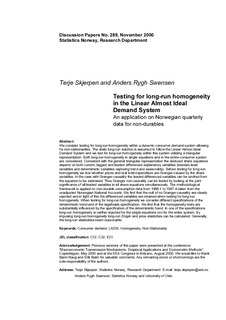| dc.contributor.author | Skjerpen, Terje | |
| dc.contributor.author | Swensen, Anders Rygh | |
| dc.date.accessioned | 2011-11-28T23:02:58Z | |
| dc.date.available | 2011-11-28T23:02:58Z | |
| dc.date.issued | 2000 | |
| dc.identifier.issn | 1892-753x | |
| dc.identifier.uri | http://hdl.handle.net/11250/179995 | |
| dc.description.abstract | Abstract:
We consider testing for long-run homogeneity within a dynamic consumer demand system allowing for non-stationarities. The static long-run solution is assumed to follow the Linear Almost Ideal Demand System and we test for long-run homogeneity within this system utilizing a triangular representation. Both long-run homogeneity in single equations and in the entire consumer system are considered. Consistent with the general triangular representation the deduced share equations depend on both current, lagged and leaded differenced explanatory variables (besides level variables and deterministic variables capturing trend and seasonality). Before testing for long-run homogeneity we test whether prices and real total expenditure are Granger-caused by the share variables. In the case with Granger-causality the leaded differenced variables can be omitted from the equation to be estimated. Thus Granger non-causality can be tested by looking at the joint significance of all leaded variables in all share equations simultaneously. The methodological framework is applied on non-durable consumption data from 1966:1 to 1997:4 taken from the unadjusted Norwegian National Accounts. We find that the null of no Granger-causality are clearly rejected and in light of this the differenced variables are retained when testing for long-run homogeneity. When testing for long-run homogeneity we consider different specifications of the deterministic trend and of the lags/leads specification. We find that the homogeneity-tests are substantially influenced by the specification of the deterministic trend. In one of the specifications long-run homogeneity is neither rejected for the single equations nor for the entire system. By imposing long-run homogeneity long-run Engel- and price elasticties can be calculated. Generally, the long-run elasticities seem reasonable. | no_NO |
| dc.language.iso | eng | no_NO |
| dc.publisher | Statistics Norway, Research Department | no_NO |
| dc.relation.ispartofseries | Discussion Papers;No. 289 | |
| dc.subject | Consumer demand | no_NO |
| dc.subject | Homogeneity | no_NO |
| dc.subject | Linear Almost Ideal Demand System | no_NO |
| dc.subject | Non-Stationarity | no_NO |
| dc.subject | JEL classification: C12 | no_NO |
| dc.subject | JEL classification: C32 | no_NO |
| dc.subject | JEL classification: E21 | no_NO |
| dc.title | Testing for long-run homogeneity in the linear almost ideal demand system : an application on Norwegian quarterly data for non-durables | no_NO |
| dc.type | Working paper | no_NO |
| dc.subject.nsi | VDP::Social science: 200::Economics: 210::Economics: 212 | no_NO |
| dc.source.pagenumber | 33 s. | no_NO |
